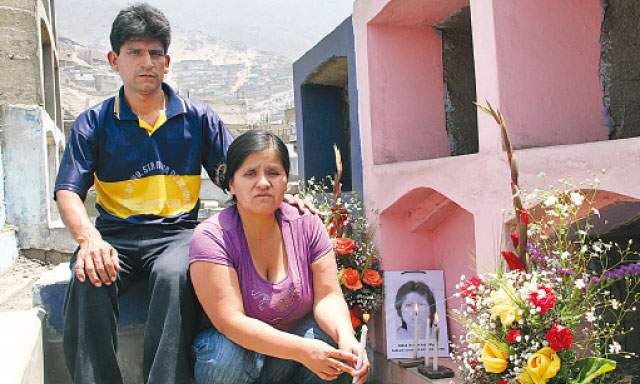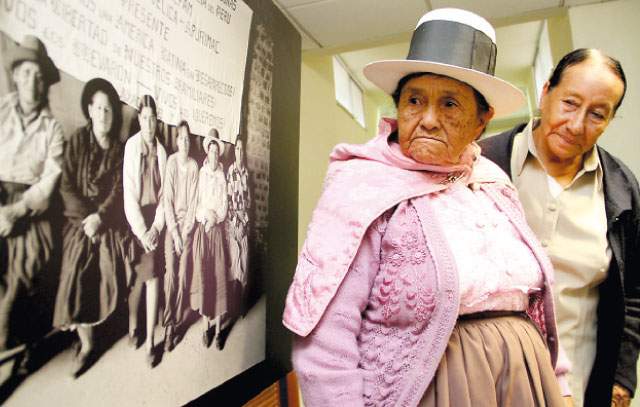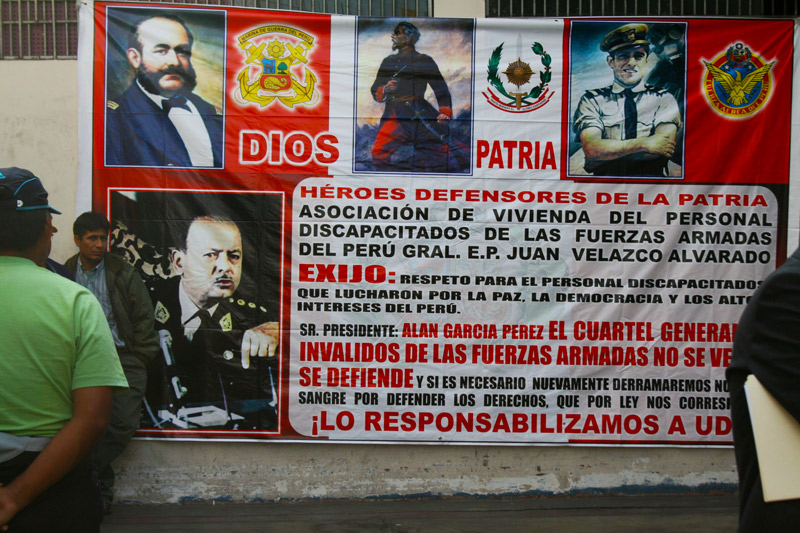By Jo-Marie Burt
In a recent article published in E-Misférica by the Hemispheric Institute of Performance and Politics the author describes the long struggle for justice by victim families who have been waiting to see the perpetrators of human rights violations stand trial.
.
1
“Waiting for justice.” The four defendants and relatives of the victims await the judges
© Emilio SalcedoOn a warm spring afternoon in Lima this past November, several people stood vigil outside the National Criminal Court in the hours before the verdict in the Parcco-Pomatambo case was to be handed down.1 At the center of the vigil was an old-fashioned scale, adorned in pink roses, with candles lit all around. Several women sat nearby, all wearing the photographs of their relatives —the victims in the Parcco-Pomatambo case— around their necks. A small sign on the ground read: “The relatives of Parcco-Pomatambo are waiting for a just verdict.”
They have been waiting 24 years.
In 1986, an army patrol on a counterinsurgency mission executed twelve members of the neighboring communities of Parcco and Pomatambo, high in the Andean mountains of Ayacucho, the epicenter of the conflict between Shining Path insurgents and the Peruvian state. According to the Peruvian Truth and Reconciliation Commission (CVR), after the massacre, the commanding officer flew by helicopter to the scene and ordered the soldiers to destroy the evidence. The bodies were dismembered, burned, and thrown into a ravine. The soldiers did not do this undercover, but in full view of several eyewitnesses. After an investigation by journalist Gustavo Gorriti and photographer Oscar Mendrano, the army admitted to the killings in a communiqué, but claimed the victims were all members of Shining Path. Among the dead were an elderly couple in their 80s and two children, ages six and twelve.
Among the relatives of the victims present at the vigil was Irene Ramírez Buitrón, who lost her elderly parents, a brother, and her niece and nephew. I first heard her speak publicly about the massacre at an event she and the relatives’ association organized last August in anticipation of the verdict. She spoke assuredly, the fear she felt over the years muted by her faith that justice was at last going to be done. She described the massacre and its aftermath, how the case had been closed by an unresponsive, perhaps complicit judicial system, how she and the other relatives spent many years feeling hopeless and isolated. The creation of the CVR in 2001, she said, had restored their hope that truth and justice might prevail, and indeed, the CVR included the Parcco-Pomatambo case as one of the 48 “emblematic” cases it recommended to be prosecuted by legal authorities. Following the presentations, members of the relatives association performed a traditional dance and staged a sort of morality play imploring their fellow citizens to empathize with their search for justice. Closing the event, six young children wearing white ponchos paraded across the stage carrying small signs. The signs read:
!Never Again
Children Orphaned
Parents Murdered!
They were the grandchildren of the victims of the Parcco-Pomatambo massacre.
2
Justice in the balance. A vigil before the final verdict
© Kristel Best UrdayThe calm of the candlelit vigil was interrupted when a group of army veterans, including some in wheelchairs, arrived on the scene. Just a few feet away from where the vigil was taking place, they unfurled a banner with images of several national heroes, foregrounded by the words “God” and “Country.” The banner read:
Heroes who defended the nation.
The ‘General Juan Velasco Alvarado’ Housing Association of Disabled Members of the Armed Forces of Peru demand: respect for handicapped personnel who fought for peace, democracy and the highest interests of Peru.
Kristel Best Urday, a Peruvian masters degree student at Universidad de la Plata in Argentina who is writing her thesis about the Parcco-Pomatambo case, noted that the veterans organization present at the vigil had not assisted any of the courtroom hearings that had taken place over the previous year. Yet at the vigil, their attitude was intimidating, and the intended effect was achieved. “The family members felt threatened by their presence,” Best Urday said, “but they remained calm and did not engage or respond to them in any way.” One of my colleagues, who was photographing the event, says one of the veterans approached him and a colleague. “So,” he said, with an air of disregard, “these are the family members of the terrorists.”
The hearing was scheduled to begin at 4:00 p.m. Eventually everyone made their way into the waiting room. There were more than one hundred people, a mix of relatives of the victims, human rights activists, relatives of the defendants, and the veterans, all anxious to ensure they were admitted. The courtroom guards warned that only 45 seats were available and no one would be allowed to stand. This generated a great deal of anxiety, compounded by the rarified ambiance generated by the hostile attitude of the veterans, who insisted that the handicapped veterans should be allowed to enter the gallery first otherwise it would amount to discrimination against the handicapped. The lawyer for the victims intervened, entreating the courtroom guard to allow the relatives of the victims, along with the elderly, to enter first. In the end, extra chairs were brought in, people were allowed to stand in the back of the room, and the relatives and elderly were escorted in first. Still, the tension in the room was palpable, even more so as family members of the victims came face to face with the family members of the four military officers on trial for the murder of their loved ones.
I have observed similar scenarios at other trials in Peru. The week before, I had attended the opening hearing for the Accomarca case—a case involving the massacre of 69 peasants by an army patrol in 1985. Several retired military commandos showed up to observe the trial, dressed in black and wearing the black berets that identify them as special forces members. Also present were retired generals dressed in business suits who were there to display their solidarity with other generals on trial in this case. Similarly, at the trial for the Barrios Altos massacre, in which 32 ex-army officers and personnel were being prosecuted for their involvement in the Colina Group death squad, retired generals would appear in the public gallery especially when the hearing pertained to other retired generals; soldiers of lesser rank did not usually merit the same attention and solidarity.
Since the first sentence was handed down by the National Criminal Court against a member of the Peruvian armed forces for human rights violations in 2007, there has been growing unrest within the Peruvian armed forces.2 State prosecutors and judges report having received “visits” expressing the military’s concerns over trials.3 An executive decree amounting to a “full stop”-style amnesty law was passed in September, but it was ultimately revoked due to intense domestic and international pressure. Then there are the public declarations of defense ministers, army generals, the vice president, and even on occasion President Alan García, accusing human rights organizations who represent the victims in these cases of “persecuting” the armed forces who “saved” Peru from terrorism. In December 2010, Vice-President (and retired navy admiral) Luis Giampetri accused two leading human rights groups of being front groups for terrorism. Not coincidentally, these groups represent the victims in the Frontón prison massacre, for which Giampetri could potentially be indicted in the not-too-near future. Some say this could also be the fate of Alan García once he steps down as president on 28 July 2011.
3
Lighting the way for justice. Irene Ramírez Buitrón, right © Kristel Best Urday
Lighting the way for justice. Irene Ramírez Buitrón, right
© Kristel Best UrdayThe judges entered the courtroom at around 5:00 p.m. The verdict was read aloud in a courtroom filled to capacity, many of us standing uncomfortably in the back of the room. The verdict was difficult to follow but by the end everyone in the room understood that the Court had acquitted all four defendants in the room. The Court urged the Public Ministry to redouble its efforts to locate the two defendants who remained at large, including Jesús Retamal Guerra, the commander of the patrol that committed the massacre, who is reportedly living in the United States. This did not allay the indignation felt by the relatives in the room. “Sure,” I heard one man mutter under his breath, “they want us to believe that they killed themselves.”
The judges noted it had been proven that the twelve victims had not been killed as the result of a confrontation, as the army had originally claimed. But they hastened to add that the killings were the “product of an excess” on the part of the armed forces. Yet the CVR specifically states that the armed forces engaged in systematic violations of human rights in certain times and in certain places. Ayacucho in 1986? Pretty safe to say that was one of those places and times.4
The Court urged the Public Ministry to identify the members of the army patrol who were the material authors of the massacre. They did not address the fact that the Defense Ministry has systematically denied providing such information in other criminal proceedings. They did not seem to consider relevant the question of command responsibility, which has proven central in many international courts to holding accountable not just the material authors of human rights crimes but also those who order them or who fail to use their power to prevent them. The verdict in the Parcco-Pomatambo case is, unfortunately, just one in a series that have been questioned by human rights activists and lawyers. An analysis of sentencing patterns of the National Criminal Court in recent years reveals a remarkable trend in favor of acquitting defendants.5
4
God and Country © Erick Ramos
God and Country © Erick RamosThe CVR opened political space in a way that was unimaginable in Peru a decade ago. Relatives’ associations have become especially active, demanding justice and reparations and organizing vigils and other events to evoke the memory of their missing loved ones. But as the Parcco-Pomatambo case shows, the central goals of truth, justice, and reparations remain an unfulfilled promise in post-CVR Peru. The relatives in the Parcco-Pomatambo case say they will appeal the ruling. Their thirst for justice remains strong, unquenched.
They are still waiting.
Jo-Marie Burt is Associate Professor of Political Science at George Mason University and Senior Fellow at the Washington Office on Latin America (WOLA). She is currently researching efforts to prosecute human rights violations committed in the context of Peru’s internal armed conflict, and is writing a book on the trial and conviction of former president Alberto Fujimori for human rights violations. She is author of Silencing Civil Society: Political Violence and the Authoritarian State in Peru (2007), which was published in Spanish as Violencia y Autoritarismo en el Perú: Bajo la sombra de Sendero y la dictadura de Fujimori (2009), and is co-editor of Politics in the Andes: Identity, Conflict, Reform (2004).
Notes
1 The National Criminal Court is a specialized tribunal established in 2005 upon recommendation of the Peruvian Truth and Reconciliation Commission to prosecute cases of human rights violations. In recent years its mandate has expanded to include other types of crimes, including drug trafficking, organized crime, money laundering, and kidnapping, thus diffusing the specialized focus of the Court. (^^^)
2 The first sentence handed down in the aftermath of the Truth and Reconciliation process was in 2006 in the case of the disappearance of university student Ernesto Castillo Páez, but the defendants were members of the National Police. (^^^)
3 Interviews conducted in Lima and Ayacucho by the author. (^^^)
4 As stated by the CVR in its report on Parcco-Pomatambo: “The Truth and Reconciliation Commission concludes that the human rights violations described above were carried out by an organized power apparatus structured on the military organization of the command post of Cangallo. In other words, a counter-subversive strategy was implemented that violated the law.” Informe Final de la Comisión de la Verdad y Reconciliación, Tomo VII, Capítulo 2.23, “Las ejecuciones extrajudiciales de Pomatambo y Parcco Alto (1986),” (2003), 254. (^^^)
5 Since 2008, the National Criminal Court has ruled in twelve cases of human rights violations committed during Peru’s internal conflict. In only four cases the Court has found at least one defendant guilty. In total, in the past three years, only six state agents have been convicted by the National Criminal Court, while 42 have been acquitted. While more state agents were acquitted than convicted in the 2005-2007 period (10 convicted, 24 acquitted), the ratio since 2008 favoring acquittal has increased exponentially. Data on file with the author as part of research project on criminal trials for human rights violations during Peru’s internal armed conflict. See also Jo-Marie Burt, “La justicia denegada, una vez más,” NoticiasSER, December 1 2010. (^^^)
… … ..
Enlace original
 © La MulaEn diálogo con LA PRIMERA, Gisela Ortiz sostuvo que primero debe esperarse cuáles son los fundamentos que esgrimirán para tal petición.
© La MulaEn diálogo con LA PRIMERA, Gisela Ortiz sostuvo que primero debe esperarse cuáles son los fundamentos que esgrimirán para tal petición. Barrios Altos © La RepúblicaVeintitrés años después de haber visto cómo el grupo Colina asesinó a balazos a su hermana Nelly Rubina Arquiñigo en una casa del jirón Huanta, en Barrios Altos, la señora Sonia siente que nuevamente se le abre esa herida, la misma que parece condenada a nunca cicatrizar.
Barrios Altos © La RepúblicaVeintitrés años después de haber visto cómo el grupo Colina asesinó a balazos a su hermana Nelly Rubina Arquiñigo en una casa del jirón Huanta, en Barrios Altos, la señora Sonia siente que nuevamente se le abre esa herida, la misma que parece condenada a nunca cicatrizar.



